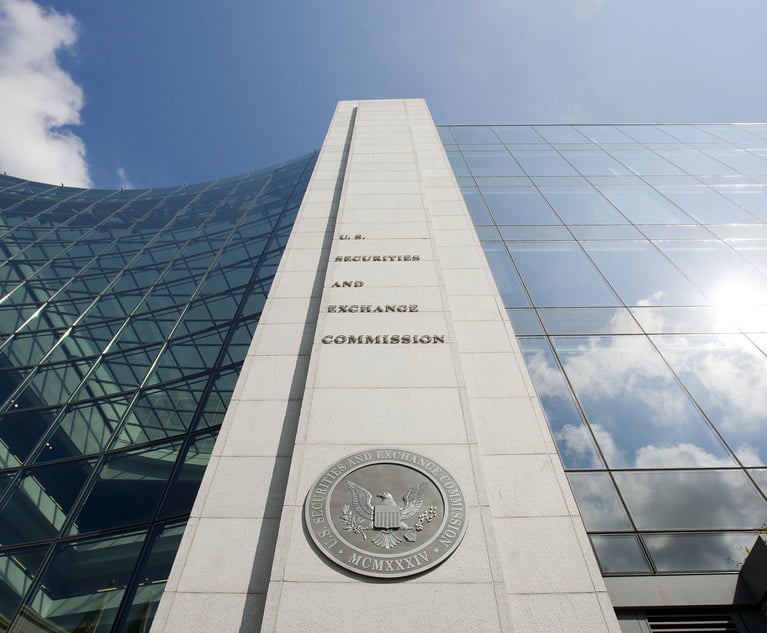Data makes the difference with non-practicing entities
Litigation is the default method transfer value between patent users and patent owners, and it is hard to imagine a less efficient form of economic exchange or price discovery.
November 21, 2013 at 07:00 PM
5 minute read
At RPX we talk a lot about the need for “market efficiency” in the patent world—about the need for a more cost-effective way to transfer value between patent users and patent owners. Today, litigation is the default method to do so, and it is hard to imagine a less efficient form of economic exchange or price discovery than a lawsuit.
In fact, of the nearly $11 billion spent by operating companies to resolve non-practicing entity (NPE) patent disputes last year, approximately half went to settlements and half to legal costs. In other words, if settlements in theory represent the agreed-upon value of the asset, then the legal expenses represent the transaction costs. This is inefficiency on a massive scale; no economically rational market would ever survive with such large transaction costs.
Now, some might say that settling an infringement suit is not an economically rational act. However, more than 95 percent of NPE cases settle. The users of the patents are paying the owners. So why not make that payment in a more efficient, market-based way that actually reflects the value of the patent rather than hold-up costs of litigation?
One major reason this hasn't happened historically is the uniquely opaque nature of litigation and settlements. Lawsuits are contentious; secrecy is a competitive advantage and there is little or no sharing of information. In a market, of course, just the opposite is true. Market transactions are mutually beneficial and participants are incented to share information that creates price transparency. Truly open, friction-free patent markets that allow the buyer or licensee to ascertain the real value of the patent require widely available, trusted transaction data.
And when such information is widely available, markets become even more efficient because participants are able to establish the common metrics that optimally determine valuations. For example, today buyers and sellers of residential real estate use the Multiple Listing Service (MLS), a centralized repository of key property attributes—square footage, number of rooms, size of lot, property taxes, and more—for every asset on the market. As a result, pricing is based on objective data and comparisons are always pertinent. Unlike a litigation settlement, in a property transaction there is no bluffing and very little guesswork. And the transaction costs are kept to minimum by the transparency of the pricing negotiations and the well-established system of brokers and other intermediaries. Freely shared data creates efficiency.
We believe this kind of openness and these kinds of commonly accepted metrics can be adopted in the patent market as well. The NPE Cost Study that RPX administered last year was a good start. For the first time, nearly 100 companies (anonymously and securely) shared information about litigation costs, patent costs and settlements, as well as data on technology area, negotiating history and other factors that can be used to determine asset valuations.
At RPX we talk a lot about the need for “market efficiency” in the patent world—about the need for a more cost-effective way to transfer value between patent users and patent owners. Today, litigation is the default method to do so, and it is hard to imagine a less efficient form of economic exchange or price discovery than a lawsuit.
In fact, of the nearly $11 billion spent by operating companies to resolve non-practicing entity (NPE) patent disputes last year, approximately half went to settlements and half to legal costs. In other words, if settlements in theory represent the agreed-upon value of the asset, then the legal expenses represent the transaction costs. This is inefficiency on a massive scale; no economically rational market would ever survive with such large transaction costs.
Now, some might say that settling an infringement suit is not an economically rational act. However, more than 95 percent of NPE cases settle. The users of the patents are paying the owners. So why not make that payment in a more efficient, market-based way that actually reflects the value of the patent rather than hold-up costs of litigation?
One major reason this hasn't happened historically is the uniquely opaque nature of litigation and settlements. Lawsuits are contentious; secrecy is a competitive advantage and there is little or no sharing of information. In a market, of course, just the opposite is true. Market transactions are mutually beneficial and participants are incented to share information that creates price transparency. Truly open, friction-free patent markets that allow the buyer or licensee to ascertain the real value of the patent require widely available, trusted transaction data.
And when such information is widely available, markets become even more efficient because participants are able to establish the common metrics that optimally determine valuations. For example, today buyers and sellers of residential real estate use the Multiple Listing Service (MLS), a centralized repository of key property attributes—square footage, number of rooms, size of lot, property taxes, and more—for every asset on the market. As a result, pricing is based on objective data and comparisons are always pertinent. Unlike a litigation settlement, in a property transaction there is no bluffing and very little guesswork. And the transaction costs are kept to minimum by the transparency of the pricing negotiations and the well-established system of brokers and other intermediaries. Freely shared data creates efficiency.
We believe this kind of openness and these kinds of commonly accepted metrics can be adopted in the patent market as well. The NPE Cost Study that RPX administered last year was a good start. For the first time, nearly 100 companies (anonymously and securely) shared information about litigation costs, patent costs and settlements, as well as data on technology area, negotiating history and other factors that can be used to determine asset valuations.
This content has been archived. It is available through our partners, LexisNexis® and Bloomberg Law.
To view this content, please continue to their sites.
Not a Lexis Subscriber?
Subscribe Now
Not a Bloomberg Law Subscriber?
Subscribe Now
NOT FOR REPRINT
© 2025 ALM Global, LLC, All Rights Reserved. Request academic re-use from www.copyright.com. All other uses, submit a request to [email protected]. For more information visit Asset & Logo Licensing.
You Might Like
View All
Antitrust in Trump 2.0: Expect Gap Filling from State Attorneys General
6 minute read

From Reluctant Lawyer to Legal Trailblazer: Agiloft's GC on Redefining In-House Counsel With Innovation and Tech
7 minute read
Ad Agency Legal Chief Scores $12M Golden Parachute in $13B Sale to Rival
3 minute readTrending Stories
- 1‘The Decision Will Help Others’: NJ Supreme Court Reverses Appellate Div. in OPRA Claim Over Body-Worn Camera Footage
- 2MoFo Associate Sees a Familiar Face During Her First Appellate Argument: Justice Breyer
- 3Antitrust in Trump 2.0: Expect Gap Filling from State Attorneys General
- 4People in the News—Jan. 22, 2025—Knox McLaughlin, Saxton & Stump
- 5How I Made Office Managing Partner: 'Be Open to Opportunities, Ready to Seize Them When They Arise,' Says Lara Shortz of Michelman & Robinson
Who Got The Work
J. Brugh Lower of Gibbons has entered an appearance for industrial equipment supplier Devco Corporation in a pending trademark infringement lawsuit. The suit, accusing the defendant of selling knock-off Graco products, was filed Dec. 18 in New Jersey District Court by Rivkin Radler on behalf of Graco Inc. and Graco Minnesota. The case, assigned to U.S. District Judge Zahid N. Quraishi, is 3:24-cv-11294, Graco Inc. et al v. Devco Corporation.
Who Got The Work
Rebecca Maller-Stein and Kent A. Yalowitz of Arnold & Porter Kaye Scholer have entered their appearances for Hanaco Venture Capital and its executives, Lior Prosor and David Frankel, in a pending securities lawsuit. The action, filed on Dec. 24 in New York Southern District Court by Zell, Aron & Co. on behalf of Goldeneye Advisors, accuses the defendants of negligently and fraudulently managing the plaintiff's $1 million investment. The case, assigned to U.S. District Judge Vernon S. Broderick, is 1:24-cv-09918, Goldeneye Advisors, LLC v. Hanaco Venture Capital, Ltd. et al.
Who Got The Work
Attorneys from A&O Shearman has stepped in as defense counsel for Toronto-Dominion Bank and other defendants in a pending securities class action. The suit, filed Dec. 11 in New York Southern District Court by Bleichmar Fonti & Auld, accuses the defendants of concealing the bank's 'pervasive' deficiencies in regards to its compliance with the Bank Secrecy Act and the quality of its anti-money laundering controls. The case, assigned to U.S. District Judge Arun Subramanian, is 1:24-cv-09445, Gonzalez v. The Toronto-Dominion Bank et al.
Who Got The Work
Crown Castle International, a Pennsylvania company providing shared communications infrastructure, has turned to Luke D. Wolf of Gordon Rees Scully Mansukhani to fend off a pending breach-of-contract lawsuit. The court action, filed Nov. 25 in Michigan Eastern District Court by Hooper Hathaway PC on behalf of The Town Residences LLC, accuses Crown Castle of failing to transfer approximately $30,000 in utility payments from T-Mobile in breach of a roof-top lease and assignment agreement. The case, assigned to U.S. District Judge Susan K. Declercq, is 2:24-cv-13131, The Town Residences LLC v. T-Mobile US, Inc. et al.
Who Got The Work
Wilfred P. Coronato and Daniel M. Schwartz of McCarter & English have stepped in as defense counsel to Electrolux Home Products Inc. in a pending product liability lawsuit. The court action, filed Nov. 26 in New York Eastern District Court by Poulos Lopiccolo PC and Nagel Rice LLP on behalf of David Stern, alleges that the defendant's refrigerators’ drawers and shelving repeatedly break and fall apart within months after purchase. The case, assigned to U.S. District Judge Joan M. Azrack, is 2:24-cv-08204, Stern v. Electrolux Home Products, Inc.
Featured Firms
Law Offices of Gary Martin Hays & Associates, P.C.
(470) 294-1674
Law Offices of Mark E. Salomone
(857) 444-6468
Smith & Hassler
(713) 739-1250






